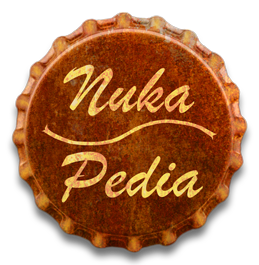m (id) Tag: sourceedit |
Jspoelstra (talk | contribs) (→Notes) |
||
| (16 intermediate revisions by 8 users not shown) | |||
| Line 2: | Line 2: | ||
|games =FO4 |
|games =FO4 |
||
|icon = |
|icon = |
||
| − | |image = |
+ | |image =Syringer ammo.png |
|weight =0.1 |
|weight =0.1 |
||
|value =40 |
|value =40 |
||
| Line 11: | Line 11: | ||
==Characteristics== |
==Characteristics== |
||
| + | The Lock Joint syringe is a small dart used only in the [[Syringer (Fallout 4)|Syringer]], fired via compressed air to deliver powerful poisons into enemy targets. Unlike most ammunition in the game, it is located under the "AID" section of the Pip-Boy menu and has a small amount of weight. |
||
| − | The Lock Joint syringe is a small little syringe akin to that of a tranq dart. |
||
| − | The Lock Joint syringe is not actually considered [[Ammunition]] instead it is located under aid and has weight (Although a very low amount of weight). |
||
| − | == |
+ | ===Crafting=== |
| − | Chance to paralyze for 10 seconds. Once paralyzed, the enemy will simply fall over, frozen. |
||
| − | |||
| − | ==Crafting== |
||
{{Crafting table |
{{Crafting table |
||
|material1 =[[Dirty water (Fallout 4)|Dirty water]] |
|material1 =[[Dirty water (Fallout 4)|Dirty water]] |
||
|material2 =[[Lead (Fallout 4)|Lead]] |
|material2 =[[Lead (Fallout 4)|Lead]] |
||
|material#2 =4 |
|material#2 =4 |
||
| − | |material3 =[[Steel]] |
+ | |material3 =[[Steel (Fallout 4)|Steel]] |
|material4 =[[Stingwing barb]] |
|material4 =[[Stingwing barb]] |
||
| − | |material5 =[[Tarberry]] |
+ | |material5 =[[Tarberry (Fallout 4)|Tarberry]] |
|material#5 =2 |
|material#5 =2 |
||
| − | |workspace =[[Chemistry station]] |
+ | |workspace =[[Chemistry station (Fallout 4)|Chemistry station]] |
|product1 =Lock Joint syringe |
|product1 =Lock Joint syringe |
||
|product#1 =1 |
|product#1 =1 |
||
}} |
}} |
||
| + | |||
| + | ==Effects== |
||
| + | When injected into an enemy, the target will have a random chance of being paralyzed for 10 seconds. Paralyzed targets will "freeze" in whatever position they're in like statues, typically falling over, rendering them vulnerable to any attack until the effect wears off. |
||
==Weapons using this ammunition== |
==Weapons using this ammunition== |
||
| − | [[Syringer]] |
+ | * [[Syringer (Fallout 4)|Syringer]] |
==Locations== |
==Locations== |
||
| − | * |
+ | * Can be crafted by the [[Sole Survivor]]. |
| + | ==Notes== |
||
| ⚫ | |||
| + | * Affected by [[Chemist]] perk and BioCommMesh armor mod which boost the effect up to 45 seconds of paralyzed. |
||
| − | The Lock Joint syringe references tetanus also known as lockjaw and lock joint. Usually caused by metal or rust getting into the body by puncture the materials needed for constructing this syringe reference this. |
||
| ⚫ | |||
| + | The Lock Joint syringe references tetanus, also known as lockjaw and lock joint. Aside from the name, the materials required to craft this item are a nod to the common association of rusty metal to the infection. Rust itself doesn't cause tetanus, but does provide an ideal environment for the bacterium ''Clostridium tetani'' to develop. |
||
| + | {{Navbox ammo FO4}} |
||
[[Category:Fallout 4 ammunition]] |
[[Category:Fallout 4 ammunition]] |
||
Revision as of 20:14, 29 November 2019
Lock Joint syringe is an ammunition type in Fallout 4.
Characteristics
The Lock Joint syringe is a small dart used only in the Syringer, fired via compressed air to deliver powerful poisons into enemy targets. Unlike most ammunition in the game, it is located under the "AID" section of the Pip-Boy menu and has a small amount of weight.
Crafting
| Materials: | Requirements: | Produces: | ||
|---|---|---|---|---|
Dirty water (1) Lead (4) Steel (1) Stingwing barb (1) Tarberry (2) | Lock Joint syringe (1) |
Effects
When injected into an enemy, the target will have a random chance of being paralyzed for 10 seconds. Paralyzed targets will "freeze" in whatever position they're in like statues, typically falling over, rendering them vulnerable to any attack until the effect wears off.
Weapons using this ammunition
Locations
- Can be crafted by the Sole Survivor.
Notes
- Affected by Chemist perk and BioCommMesh armor mod which boost the effect up to 45 seconds of paralyzed.
Behind the scenes
The Lock Joint syringe references tetanus, also known as lockjaw and lock joint. Aside from the name, the materials required to craft this item are a nod to the common association of rusty metal to the infection. Rust itself doesn't cause tetanus, but does provide an ideal environment for the bacterium Clostridium tetani to develop.
|
